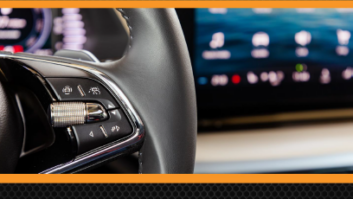WFCR Appreciates ADA Dual Tuner’s 2 RU Size, Confidence Monitor for Additional Program Streams
(click thumbnail)WFCR’s HD Pro Dual Radio Monitor (top)
As more stations implement HD Radio at their transmission plants, new monitoring and test equipment becomes necessary. The broadcaster must have an accurate way to monitor what the public will be receiving in order to ensure that the product is delivered as intended.
For many stations, the way to monitor their HD Radio transmissions has been restricted to consumer receivers, as the selection of professional equipment has been rather limited. But as 2006 rolls on, new products have hit the shelves offering a variety of functions advantageous to the broadcaster.
One such product is the Audio Design Associates HD Pro dual radio monitor, which features two independent AM and FM HD Radio (plus weather band) tuners in one package.
On display
The ADA HD PRO is not a modulation monitor or diagnostic device in the fashion of displaying spectral analysis – which would be somewhat ineffectual in its price range – or bit error rates. The focus of the design is high-quality decoded HD Radio (or analog) audio, along with features useful at the TOC or main studio. There is no provision to measure SCA levels or modulation.
The ability not only to monitor programming, but to know if there is silence on a multicast channel due to an automation or transmitter failure is key. And given that many stations now must monitor FM, HD Radio, multicasting and Web streaming, a tool that will provide the confidence check on the additional program streams is valuable.
(click thumbnail)Rear Panel
The ADA HD PRO provides such a confidence monitor, complete with relay closures to trigger external alarms should an audio loss or carrier failure occur.
Enclosed in a well-ventilated (forced fan-cooled) metal chassis just two rack spaces high, the HD PRO tuner is a welcome addition to any equipment rack. The sleek black brushed-metal front panel is clean and simple. Two display windows encapsulate most of the function controls with exception of the power switch and headphone controls.
The first window contains a softly lit LCD display that shows station information and RBDS data. Push buttons allow the user to dedicate the display to a particular tuner, control the mode of reception (digital, analog or mono), select the band (AM and FM broadcast or VHF weather), select that band’s optional filter (high-frequency for broadcast and voice-pass for VHF), and activate the RBDS portion of the LCD display while in the FM (analog) broadcast mode.
There are buttons to control the manual tuning or seek functions, while others comprise the keys for direct frequency entry and preset storage/retrieval. The buttons themselves are small but spaced so as to not become a problem to those with “big-boned” fingertips.
I found the lack of menu-driven controls to be refreshing. For instance, without undue clutter each function is immediately accessible and one doesn’t have to fuss with multilevel menu selections to change the mode from FM to HD, unlike some consumer receivers.
For the broadcast engineer, a “split” mode function routes the analog of the broadcast station to the selected tuner’s right channel, with the HD Radio audio (if applicable) appearing on the left. And again, no multiple menu steps to get there – just one button. This is a helpful feature in audibly time-aligning or verifying the analog latency in an HD Radio installation, or for use with an oscilloscope for the same.
The larger of the two display windows contains LED bar graphs that indicate signal presence, HD Radio decoding, and left and right levels for both receivers’ audio. The 20-segment VU meters, including a peak hold indicator, are valuable as a rough modulation monitor for the studio operator. The LED VU meters are bright and visible from across the room, although these could be somewhat distracting if situated in an operator’s field of vision. In setting the second tuner to HD-2, one can use these meters as a constant program confidence check, or make useful comparisons between HD-1 and HD-2 levels. Signal strength is indicated by additional LED meters for each tuner, which are helpful in peaking an antenna for best reception.
Product CapsuleThumbs Up
Versatile, fine audio quality
Warning system function
Dual receivers allow easy comparison of stations
Sleek look
Sensitive
Uses two rack spaces
Software (remote) controllable
Quick acquisition of HD Radio mode
Thumbs Down
VU Level LEDs are rather bright – perhaps too bright
Lacks S/PDIF output
Limited troubleshooting capabilities
No modulation, multipath or SCA level indication
Price: $3,500
Contact: Audio Design Associates in New York at (800) HD AUDIO (432-8346) or visit www.ada-usa.com
When I was bench-testing the HD PRO, one of my colleagues took little time to react to the lack of activity on the meters for the tuner set to our station’s HD-2 signal; she had grown used to seeing it as active. She didn’t know I had disconnected that tuner’s antenna for another purpose. It’s a good visual indicator of whether or not all is well, without having to listen to the programming 24/7.
PC compatibility
The ADA HD PRO gives away its lineage in its PC accessibility. ADA’s history is steeped in the manufacturing of tuners, preamplifiers, amplifiers and signal routing controllers for remote controlled multiroom and home theatre installations. Therefore it is natural that an ADA product of this level includes PC control compatibility.
Included with HD PRO is a TuneSuite software CD-ROM. Your PC will connect to the HD PRO tuner using the included Ethernet cable – they provide you with the cable, unlike some printer manufacturers.
After a simple installation and configuration following the easy-to-read instructions provided in the hard copy manual, you connect using the crossover cable and a user-friendly screen provides the features of the tuners’ front-panel controls and text data. The data port speaks Ethernet or may be ordered with RS-232.
For those keen on being sure their station on the air stays on the air, the ADA HD PRO includes a “warning system” to alert station personnel to the loss of program or transmitter failure. The rear panel contains DIP switches that set the reaction mode of the alarm closures, allowing HD failure, low audio level or outright carrier failure to trigger the closure. The trim pots set the RF threshold for the RF level alarm. A power-up timer, set with DIP switches, helps avoid false triggers during power-up of the HD Pro.
Balanced audio output for both tuners is provided, as are unbalanced RCA outputs, TOS-Link and AES/EBU digital outputs. Located on the front, headphone jack controls include the ability to toggle between the two tuner modules for audio comparison between two stations, HD and FM, etc.
A 15-watt amp drives the headphone jack. I did not listen to the HD PRO through what some would consider a “high-end’ audiophile system; I did compare the audio quality to some conventional receivers and found the HD PRO to be satisfactory.
Through an NAD L53 receiver and B&W DM601-S3 bookshelf speakers, I could discern a clear difference between the NAD’s FM tuner (of reasonable quality) and the HD Pro. Instruments had a clearer individuality and the soundstage was more stable. I am confident most would find the sound listenable and the resolution suitable for critical listening while adjusting station processing. Its sensitivity easily beat that of the NAD, which was pretty fair.
With the HD PRO, I was able to hear the subtle differences between our station’s FM and HD (WFCR features a lightly processed classical music and jazz format).
With its ergonomic design, the HD PRO dual radio monitor is a welcome addition to ADA’s line of tuners and shows the company’s intention of catering to the needs of the broadcast industry.
The ADA line is built by hand at the company’s White Plains, N.Y., factory; it is available direct or through retailers like Broadcasters General Store ( www.bgs.cc ) and SCMS ( www.scmsinc.com ).
At a suggested list price of $3,500, the price is well within that expected for professional quality and specialized use. It offers features not found in conventional tuners and receivers, and yet omits some of the highly expensive functions found in high-level monitoring products.
While the home audiophile will appreciate the sound quality and ease of use (as well as looks), the broadcast engineer is sure to value the “warning system” and features germane to HD Radio listening. This station monitor is a pleasure to use as well as listen to.














